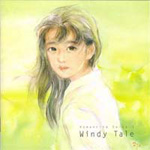Romancing SaGa 3 -Windy Tale-
 |
Album Title: Romancing SaGa 3 -Windy Tale- |
| Record Label: NTT Publishing |
|
| Catalog No.: PSCN-5043 (1st Edition); NTCP-5043 (2nd Edition) |
|
| Release Date: January 25, 1996; October 1, 2004 |
|
| Purchase: Buy at CDJapan |
Overview
Romancing SaGa 3 -Windy Tale- closed a trilogy of arranged albums that portrayed the romantic aura of SaGa’s Super Nintendo titles. After the French-styled deviations of Romancing SaGa -La Romance- and overexuberant symphonies of Romancing SaGa 2 -Eternal Romance-, cinematic composer Taro Iwashiro decided to take a somewhat different approach to conveying the romantic aura of the series. The result is one of the finest arranged albums ever created.
Body
The continuity between Romancing SaGa 2 -Eternal Romance- and Romancing SaGa 3 -Windy Tale- is evident right from the overture. Both are slow expressive orchestrations influenced by the great romantics and cinematic legends in equal measure. Both feature gushing suspended strings and elevating piano passages in romantic tradition. Yet Taro Iwashiro’s orchestration is not quite as exuberant as Ryo Fukui’s, with its more modest dramatic arch and focus on longing suspensions. In many ways, this is an advantage as it avoids listeners feeling overwhelmed by excessive emotion and leaves room for more expansive additions later in the album.
As the title suggests, Romancing SaGa 3 -Windy Tale- focuses on telling a story rather than simply serving as art music. This is instantly evident in the rendition of the series’ main theme in the second track, with its nostalgic cinematic introduction, slow-building development, and unresolved conclusion. It builds substantially on the overture, both in terms of its thicker orchestration and longer length, without going overboard and unsettling the listener. The arch established, the rest of the album explores romance — both from the perspective of personal feelings and outward circumstances — in a range of manners.
Showing his classical sensibilities, Iwashiro transforms “A Shy Smile” into a piano quintet featuring infleunces from Beethoven. This emulation is spot on from a technical perspective, but also very effective for the way it continues the romantic story and related to the original. It stays faithful to the character and melody of Kenji Ito’s theme, but presents it in a much more sophisticated and effective manner. Likewise, the lush transient colours of “Stardust Waltz” and scenic stylistic shifts in “Lost Memories” provide some of the most musically impressive moments of the album, while taking listeners further into the realms of fantasy.
The magic of Taro Iwashiro’s approach is further reflected on the town theme. From a technical perspective, the orchestration is more functional and less ornate than Ryo Fukui’s. However, the emotions it inspires are potentially stronger and, in particular, the flute melody will inspire great contemplation with its wavering shape and beautiful performance. His expression of intimacy on “Two Hearts” is also beautifully achieved, with cello expressions and flute flourishes interweaving around colourful harp arpeggios. The approach is somewhat stereotypical, but is achieved in a sufficiently mature way that this is not a major disadvantage.
Further building on Romancing SaGa 2 -Eternal Romance-, Taro Iwashiro ensures vocals are an essential part of the album. A soprano voice ensures the climaxes of the fantasy-styled waltz “Fairy’s Whisper”, a fantasy-styled waltz and the elegaic interlude “Tears” are all the more meaningful. It gives these tracks a special quality despite their somewhat trite orchestration. The vocals take a more central role on “Windy Tale ~What the Wind Taught Me~”, a lavishly orchestrated ballad. Unlike Square’s ballads that succeeded it, this track still maintains a mature quality thanks to the lush orchestration and powerful performance. It also fits the fantasy concept theme of the album and, with its reprise of the surprisingly flexible melody from the overture, ties together the soundtrack thematically.
Summary
Clearly, Romancing SaGa 3 -Windy Tale- is an impressive achievement. Given Taro Iwashiro’s background as a cinematic rather than art composer, the orchestration isn’t always as elaborate as the preceding album, but it usually has more evocative and meaningful effects. Unlike the vast majority of albums out there, Romancing SaGa 3 -Windy Tale- manages to stand up well as an arranged album, concept album, and work of art, and as such gains my unconditional recommendation.
Do you agree with the review and score? Let us know in the comments below!
5
Posted on August 1, 2012 by Dave Valentine. Last modified on August 1, 2012.














